#Soviet Monument Destroyed
Video
undefined
tumblr
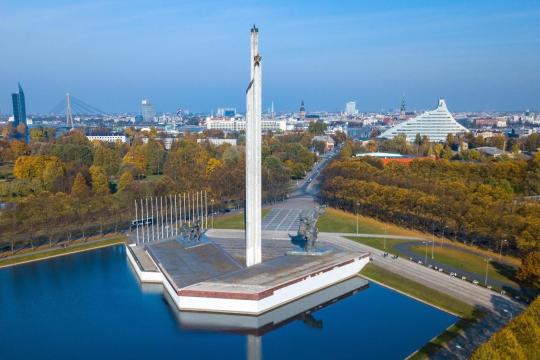
We All Fall Down
A nearly 80-meter (260-foot) concrete obelisk with Soviet stars at the top that was the center piece of a monument commemorating the Red Army’s victory over Nazi Germany, has been demolished Thursday in the Latvian capital Riga.
23 notes
·
View notes
Text
What does life in North Korea look like outside of Pyongyang? 🇰🇵
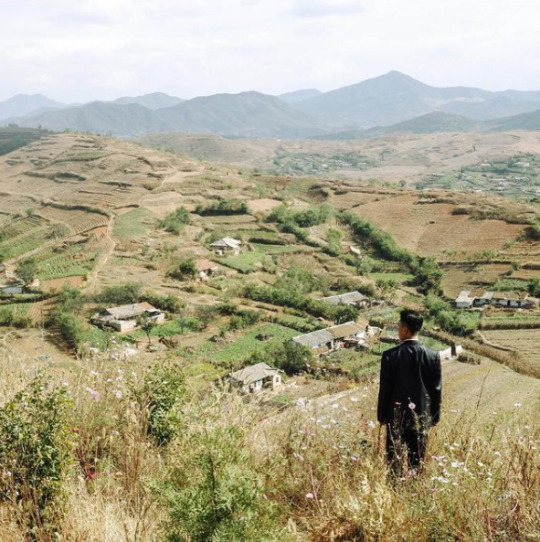
Hey, I'm back again with a very scary "tankie" post that asks you to think of North Koreans as people, and to consider their country not as a cartoonish dystopia, but as a nation that, like any other place on earth, has culture, traditions, and history.
Below is a collection of pictures from various cities and places in North Korea, along with a brief dive into some of the historical events that informs life in the so-called "hermit kingdom."
Warning: very long post
Kaesong, the historic city
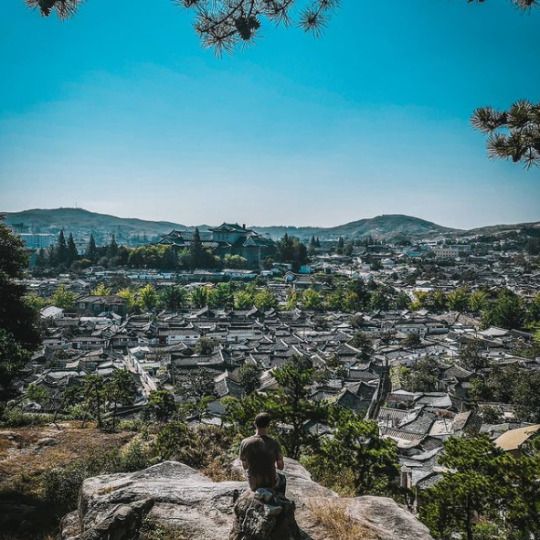
Beginning this post with Kaesong, one of the oldest cities in Korea. It's also one of the few major cities in the DPRK (i.e. "North Korea") that was not completely destroyed during the Korean war.
Every single city you'll see from this point on were victims of intense aerial bombardments from the U.S. and its allies, and had to be either partially or completely rebuilt after the war.
From 1951 to 1953, during what has now become known as the "forgotten war" in the West, the U.S. dropped 635,000 tons of bombs over Korea — most of it in the North, and on civilian population centers. An additional 32,000 tons of napalm was also deployed, engulfing whole cities in fire and inflicting people with horrific burns:
For such a simple thing to make, napalm had horrific human consequences. A bit of liquid fire, a sort of jellied gasoline, napalm clung to human skin on contact and melted off the flesh. Witnesses to napalm's impact described eyelids so burned they could not be shut and flesh that looked like "swollen, raw meat." - PBS
Ever wondered why North Koreans seem to hate the U.S so much? Well...
Keep in mind that only a few years prior to this, the U.S. had, as the first and only country in the world, used the atomic bomb as a weapon of war. Consider, too, the proximity between Japan and Korea — both geographically and as an "Other" in the Western imagination.
As the war dragged on, and it became clear the U.S. and its allies would not "win" in any conventional sense, the fear that the U.S. would resort to nuclear weapons again loomed large, adding another frightening dimension to the war that can probably go a long way in explaining the DPRK's later obsession with acquiring their own nuclear bomb.
But even without the use of nuclear weapons, the indiscriminate attack on civilians, particularly from U.S. saturation bombings, was still horrific:
"The number of Korean dead, injured or missing by war’s end approached three million, ten percent of the overall population. The majority of those killed were in the North, which had half of the population of the South; although the DPRK does not have official figures, possibly twelve to fifteen percent of the population was killed in the war, a figure close to or surpassing the proportion of Soviet citizens killed in World War II" - Charles K. Armstrong
On top of the loss of life, there's also the material damage. By the end of the war, the U.S. Air Force had, by its own estimations, destroyed somewhere around 85% of all buildings in the DPRK, leaving most cities in complete ruin. There are even stories of U.S. bombers dropping their loads into the ocean because they couldn't find any visible targets to bomb.
What you'll see below of Kaesong, then, provides both a rare glimpse of what life in North Korea looked like before the war, and a reminder of what was destroyed.

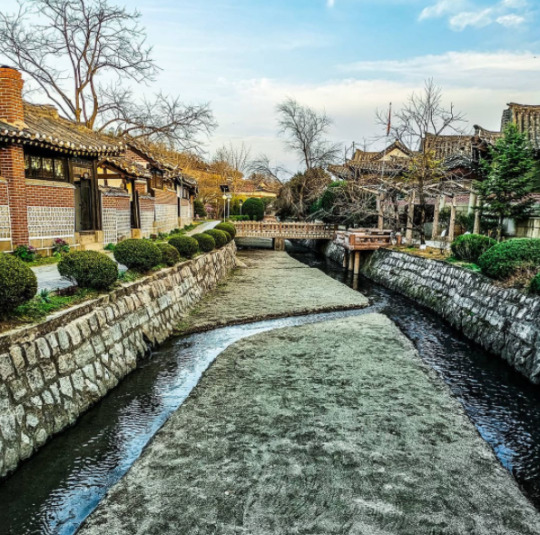

Kaesong's main street, pictured below.
Due the stifling sanctions imposed on the DPRK—which has, in various forms and intensities, been in effect since the 1950s—car ownership is still low throughout the country, with most people getting around either by walking or biking, or by bus or train for longer distances.
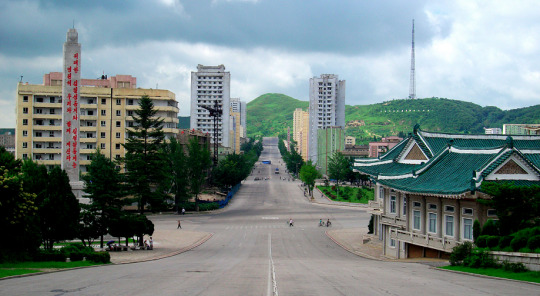
Kaesong, which is regarded as an educational center, is also notable for its many Koryŏ-era monuments. A group of twelve such sites were granted UNESCO world heritage status in 2013.
Included is the Hyonjongnung Royal Tomb, a 14th-century mausoleum located just outside the city of Kaesong.
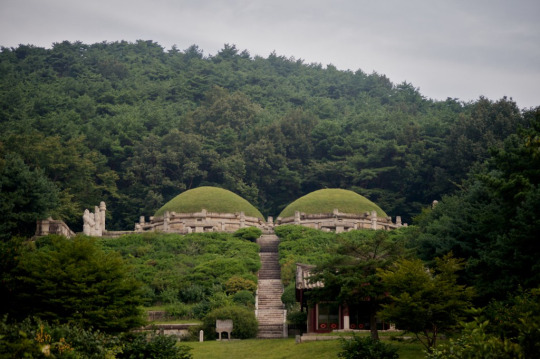
One of the statues guarding the tomb.
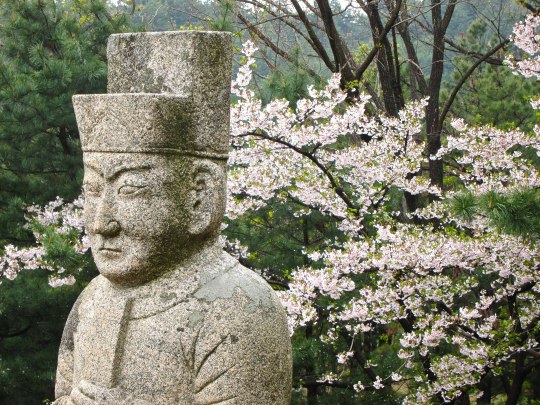
Before moving on the other cities, I also wanted to showcase one more of the DPRK's historical sites: Pohyonsa, a thousand-year-old Buddhist temple complex located in the Myohyang Mountains.

Like many of DPRK's historic sites, the temple complex suffered extensive damage during the Korean war, with the U.S. led bombings destroying over half of its 24 pre-war buildings.
The complex has since been restored and is in use today both as a residence for Buddhist monks, and as a historic site open to visitors.


Hamhung, the second largest city in the DPRK.
A coastal city located in the South Hamgyŏng Province. It has long served as a major industrial hub in the DPRK, and has one of the largest and busiest ports in the country.
Hamhung, like most of the coastal cities in the DPRK, was hit particularly hard during the war. Through relentless aerial bombardments, the US and its allies destroyed somewhere around 80-90% percent of all buildings, roads, and other infrastructure in the city.
Now, more than seventy years later, unexploded bombs, mortars and pieces of live ammunition are still being unearthed by the thousands in the area. As recently as 2016, one of North Korea's bomb squads—there's one in every province, faced with the same cleanup task—retrieved 370 unexploded mortar rounds... from an elementary school playground.
Experts in the DPRK estimate it will probably take over a hundred years to clean up all the unexploded ordnance—and that's just in and around Hamhung.
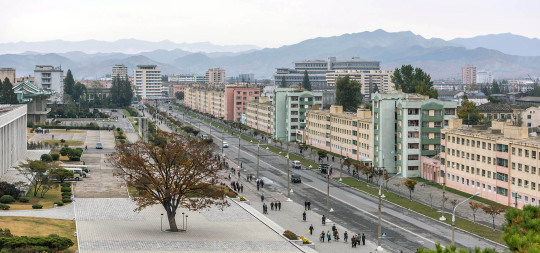

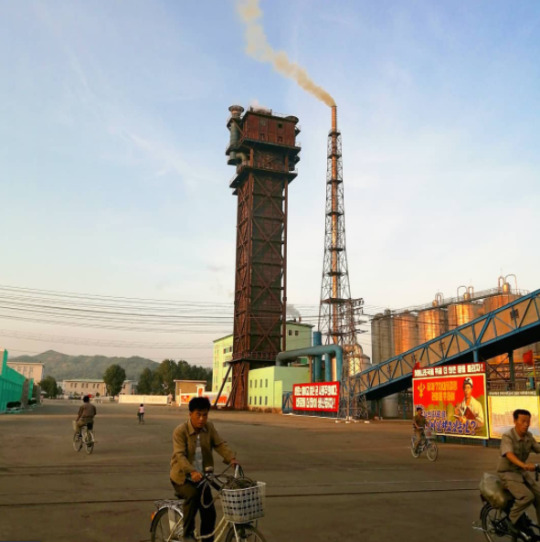
Hamhung's fertilizer plant, the biggest in North Korea.
When the war broke out, Hamhung was home to the largest nitrogen fertilizer plant in Asia. Since its product could be used in the creation of explosives, the existence of the plant is considered to have made Hamhung a target for U.S. aggression (though it's worth repeating that the U.S. carried out saturation bombings of most population centers in the country, irrespective of any so-called 'military value').
The plant was immediately rebuilt after the war, and—beyond its practical use—serves now as a monument of resistance to U.S. imperialism, and as a functional and symbolic site of self-reliance.
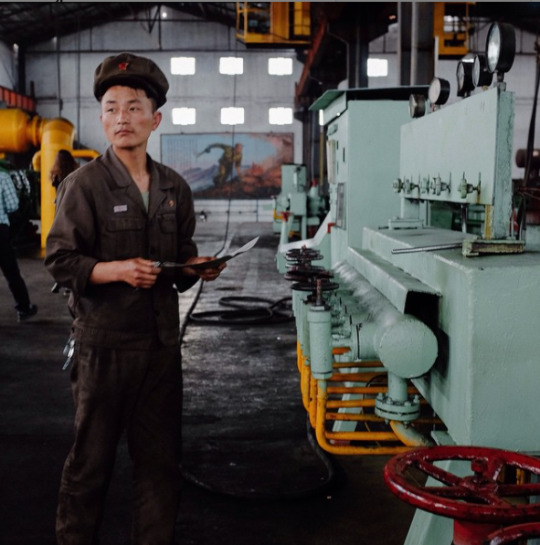
Chongjin, the third largest city in the DPRK.
Another coastal city and industrial hub. It underwent a massive development prior to the Korean war, housing around 300,000 people by the time the war broke out.
By 1953, the U.S. had destroyed most of Chongjin's industry, bombed its harbors, and killed one third of the population.
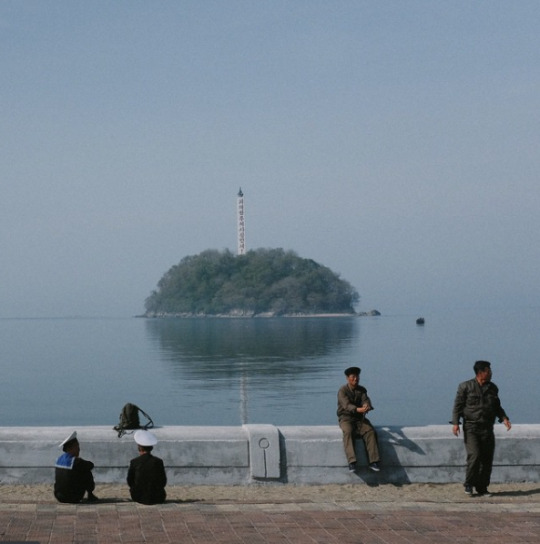
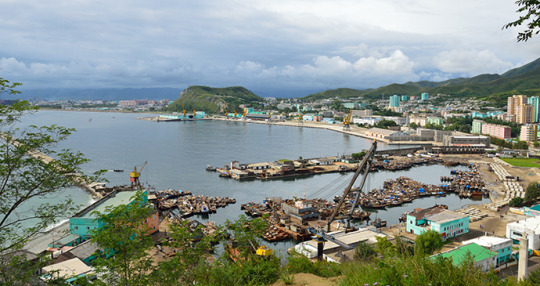

Wonsan, a rebuilt seaside city.
The city of Wonsan is a vital link between the DPRK's east and west coasts, and acts today as both a popular holiday destination for North Koreans, and as a central location for the country's growing tourism industry.
Considered a strategically important location during the war, Wonsan is notable for having endured one of the longest naval blockades in modern history, lasting a total of 861 days.
By the end of the war, the U.S. estimated that they had destroyed around 80% of the city.
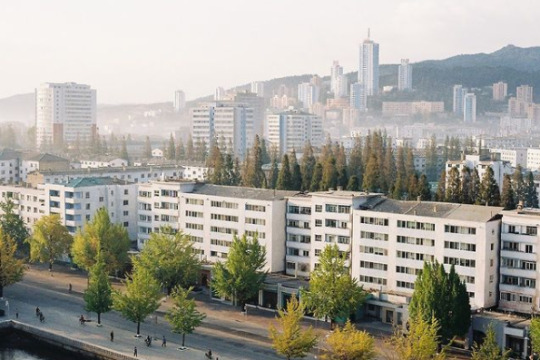

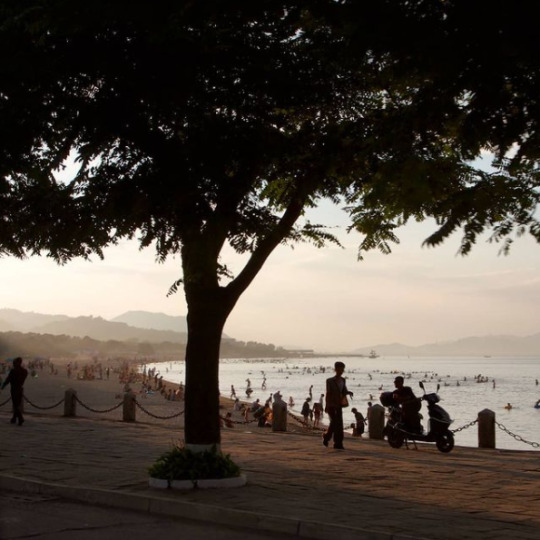

Masikryong Ski Resort, located close to Wonsan. It opened to the public in 2014 and is the first, I believe, that was built with foreign tourists in mind.
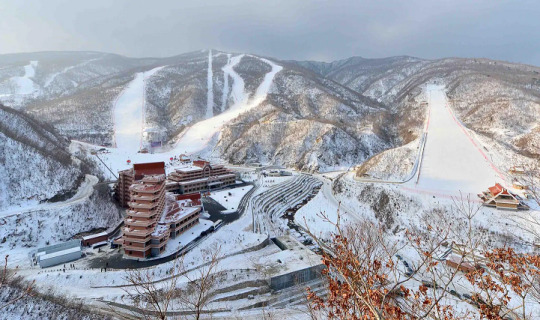
Sariwon, another rebuilt city
One of the worst hit cities during the Korean War, with an estimated destruction level of 95%.
I've written about its Wikipedia page here before, which used to mockingly describe its 'folk customs street'—a project built to preserve old Korean traditions and customs—as an "inaccurate romanticized recreation of an ancient Korean street."
No mention, of course, of the destruction caused by the US-led aerial bombings, or any historical context at all that could possibly even hint at why the preservation of old traditions might be particularly important for the city.
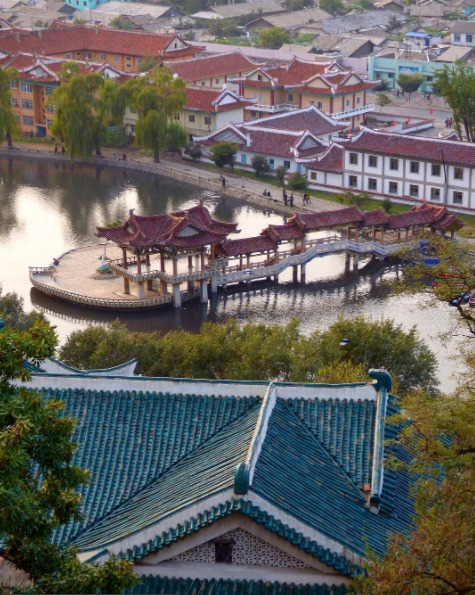

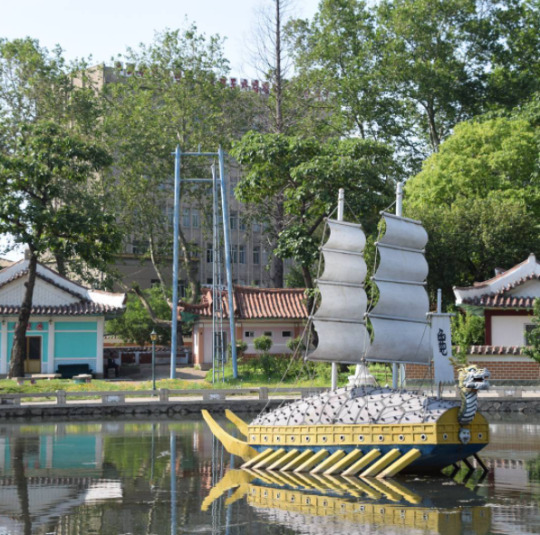
Life outside of the towns and cities
In the rural parts of the DPRK, life primarily revolves around agriculture. As the sanctions they're under make it difficult to acquire fuel, farming in the DPRK relies heavily on manual labour, which again, to avoid food shortages, requires that a large portion of the labour force resides in the countryside.
Unlike what many may think, the reliance on manual labour in farming is a relatively "new" development. Up until the crisis of the 1990s, the DPRK was a highly industrialized nation, with a modernized agricultural system and a high urbanization rate. But, as the access to cheap fuel from the USSR and China disappeared, and the sanctions placed upon them by Western nations heavily restricted their ability to import fuel from other sources, having a fuel-dependent agricultural industry became a recipe for disaster, and required an immediate and brutal restructuring.
For a more detailed breakdown of what lead to the crisis in the 90s, and how it reshaped the DPRKs approach to agriculture, check out this article by Zhun Xu.

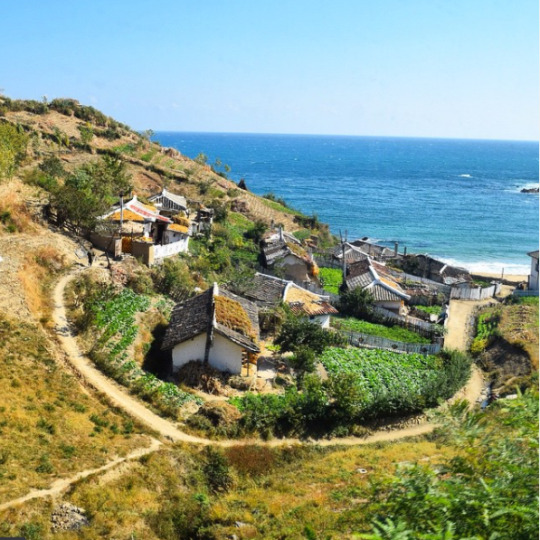
Some typical newly built rural housing, surrounded by farmland.
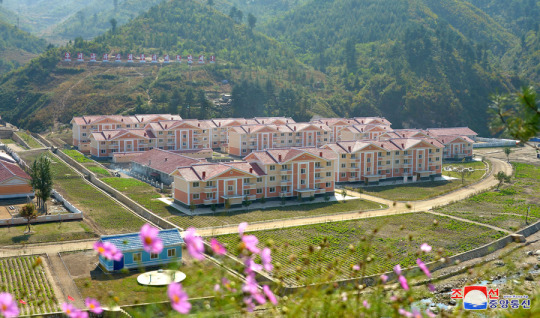
Tumblr only allows 20 pictures per post, but if you want to see more pictures of life outside Pyongyang, check out this imgur album.
#dprk#north korea#i've had this post unfinished in drafts for almost a year#also sorry about the spelling and potential formatting issues it's a nightmare to edit at this point#it was literally just meant to be a collection of picture and then the writing just sort of happened#enjoy the brief heritageposts history lesson i guess
6K notes
·
View notes
Text
AUUC('s Edmonton Branch) released a statement on the Volunteer Nazi given a standing ovation in Canadian Parliament, read it

[x]
transcription after the cut
The Edmonton Branch of the Association of United Ukrainian Canadians (AUUC) condemns the honoring of a nazi Ukrainian World War II veteran, a member of the notorious 14th Waffen SS Division "Halychyna", in the House of Commons during the visit of Ukrainian President Zelenskiy last Friday, 22 September, 2023.
Our Association, founded in 1918 in Winnipeg as the Ukrainian Labor Temple Association, has an unblemished record of opposing fascism, in word and deed, before and after WWII, in Canada, in the Ukrainian-Canadian community, and abroad. Our members fought heroically in the Spanish Civil War, on the side of the Republican government, against fascism. They fought for Canada, allied with the Soviet Union, against nazi Germany and fascist Italy in WWII.
It is therefore unbelievable to us, as to most other Canadians, that when the individual in question, Yaroslav Hunka, was introduced in parliament as a Ukrainian veteran of WWII who fought against Russia, no one in attendance, all of whom gave him two standing ovations, realized what this meant. We know exactly what it meant.
Now this shameful spectacle has been publicized to all Canadians, and throughout the world. We welcome this publicization. We hope it will lead to a reckoning. Some steps in this direction have already been taken. The speaker of the House of Commons has resigned. An endowment in the name of Yaroslav Hunka at the Canadian Institute of Ukrainian Studies, at the University of Alberta, has been returned. We welcome these steps. But they are only first steps. Much more must be done. The problem is greater than simply one nazi, one speaker, and one endowment.
It is estimated that two thousand members of the 14th Waffen SS Division "Halychyna" were allowed into Canada after WWII. Our Association, immediately at that time, publicized and opposed their entry, to our everlasting credit. This figure does not include other nazis and nazi-collaborators, of various nationalities. That means thousands of Yaroslav Hunkas. Several of them went on to occupy prominent and leading positions in certain other Ukrainian-Canadian organizations, in religious institutions, educational institutions, and state institutions. The Canadian state supports, with funding and semi-official recognition, Ukrainian-Canadian organizations that unapologetically honor these nazis. If honoring Yaroslav Hunka in the House of Commons was a shameful act that had to be corrected, then so must all these other cases be corrected.
We therefore call on the Canadian state at all three levels (federal, provincial, municipal) to halt all state funding to all Ukrainian-Canadian organizations which honor any Ukrainian nazis or nazi-collaborators, including especially veterans of the 14th Waffen SS Division "Halychyna", until such time as these organizations explicitly and unequivocally apologize for having done so, severing all connections with all these nazis and nazi-collaborators, in all forms whatsoever.
We call for the removal and dismantling of two monuments to nazi Ukrainians in Edmonton: the monument to the veterans of the 14th Waffen SS Division "Halychyna" located in St. Michael's Cemetery, and the bust of Roman Shukhevych located at the Ukrainian Youth Unity Complex, preferably by their respective property owners, and if not by them, then by state compulsion.
We call on the government of Canada, and on the Liberal Party of Canada which formed the government at the time, to issue official apologies to our Association (the AUUC), in consultation with our Association, for banning it (then named the Ukrainian Labor-Farmer Temple Association) by an order in council in June 1940, seizing its properties, our halls and their contents (furniture, musical instruments, dance costumes, books, etc., most of which were destroyed), and interning our leaders in internment camps, acknowledging this as a terrible miscarriage of justice and act of oppression.
We call on all Canadians, all progressive Canadians, all decent Canadians, all anti-fascist Canadians, individually and through their various organizations, to support us in these calls for justice, by publicizing this statement, and pressuring their political representatives.
310 notes
·
View notes
Text
Anyone who wants to understand Russian history should ignore Russian President Vladimir Putin. But anyone who wants to understand Putin’s strategic aims should pay close attention to his reading of history. The Russian president’s long lectures and essays on Kyivan Rus and World War II are not random tangents but rather the centerpieces driving his regime’s aggression against Ukraine. The Kremlin’s efforts to impose its reading of history on Ukrainians living under occupation reveal the driving motives of this war, as well as its continued objectives.
Against the backdrop of the uncounted—and uncountable—civilian deaths, mass deportations, and domicide across the occupied territories of Ukraine, it might seem trivial to focus on historical memory. But while it is difficult to take one’s eyes off the satellite images of mass graves in Mariupol, if we fail to grasp the broader grammar of Russia’s war against Ukraine, then we will also fail to recognize the broader ambition of Russia’s war efforts: the deliberate annihilation of Ukrainian identity.
Russia’s strategic deployment of historical propaganda in occupied Ukraine involves a comprehensive effort to “Russify” the local populace, leveraging educational, cultural, and military instruments to erase narratives of Ukrainian history and culture.
Those who resist this erasure are themselves destroyed, often physically. In all of the occupied territories, Russian forces arrived with a list of reportedly patriotic individuals to be captured; tortured; and, if they did not break, executed. From the very beginning, as Putin made clear in a June 2021 essay titled “On the Historical Unity of Russians and Ukrainians,” Russia’s full-scale invasion was intended as a genocidal war.
Genocide aims at the annihilation of the identity and existence of a specific group—in this case, Ukrainians. The crucial aspect of identifying genocide is the intent behind these actions, which distinguishes it from other forms of violence. Evidence of the Kremlin’s destructive intent is overwhelming. And it is overwhelmingly delivered in the language of history.
Upon taking control of the Kherson and Zaporizhzhia regions in 2022, Russia launched an aggressive cultural propaganda campaign characterized by the declaration of annexation anniversaries as national holidays, the standardization of cultural practices to align with Russian norms, the establishment of historical propaganda museums, and the re-Sovietization of street names and monuments. These endeavors were aimed at rapidly embedding the occupied territories within the broader Russian cultural and legal fabric, a strategy reminiscent of Russia’s annexation of Crimea and unlike the more fragmented methods employed in the so-called Republics of Donetsk and Luhansk in eastern Ukraine after 2014.
In regions where local resistance is more robust, such as Melitopol and Berdyansk, there is an intensified effort toward cultural and educational Russification. The formation of militarized youth groups—including the Yunarmiya (Young Army), a military-patriotic movement for children and youth initiated by Russian Defense Minister Sergei Shoigu in 2016, and Eaglets of Russia—is widespread, but the scale and visibility of such programs vary in accordance with the strategic military value of each region to Russia. The nature and intensity of the propaganda varies as well, with a pronounced emphasis on Soviet-era narratives in Donetsk and Luhansk, which were likely deliberately crafted to align with the region’s recent historical narratives and multicultural identities.
While the techniques to suppress Ukrainian identity may adapt, the core objectives of Russian informational campaigns are constant. These efforts relentlessly accentuate the regions’ shared historical and cultural roots with Russia, praising Soviet accomplishments and East Slavic heritage.
The Kremlin’s agenda aims to replace Ukrainian identity with something different—something localized—that can then be subsumed into a broader pan-Russian narrative. To do so, it uses culture and education as weapons of war. This strategy includes mobile libraries, guarded by armed militias, that distribute Russian books and educational resources while destroying Ukrainian books.
Amid this evident historical manipulation and cultural destruction, Russian propaganda distributed in the occupied territories positions the Kremlin as a protector of historical truth, using this stance to propagate narratives conducive to its political and ideological ends. It paints Western and Ukrainian histories as distortions that were deliberately aimed at destroying Russian identity—which the Kremlin argues is the true identity of Ukrainians.
The Khersonshchyna cultural project in the occupied Kherson region, for example, claims to expose Ukrainian history as a series of lies and promotes militaristic Russian myths with the aim of “restoring historical justice” and “curbing the spread of lies.”
Through the adoption of Russian curricular materials, educators, and syllabi prioritizing Russian over Ukrainian heritage, occupation authorities seek to transform residents’ identities, downplaying Ukrainian heritage in favor of a Russian outlook. Russian academics have created an Orwellian 98-page glossary of new correct cultural, historical and social terminology to be enforced in Ukrainian schools on the occupied territories. In the Donbas, organizations such as the Russian Center have produced pseudo-historical doctrines to justify Russia’s occupation. The center, which is funded by the Russian World Foundation, has held a number of festivals centered around the idea that the Donbas is Russia and that Russian culture is inherent to the Donbas.
A common thread in the historical propaganda is the idea that an injustice (Russia’s separation from the lands of what it calls the Donbas and Novorossiya—meaning “New Russia”) has been resolved by the invasion. In September 2023, on the anniversary of the pseudo-referendums held in four newly occupied territories in eastern Ukraine, schools in the Zaporizhzhia region held events to celebrate “reunification with the Russian Federation,” which was referred to as a “restoration of historical justice.” In his state of the nation speech in February 2023, Putin declared the “revival” of the cultural sphere in the occupied territories to be a priority for reestablishing peace. He emphasized the importance of restoring cultural objects to forge a connection across time, asserting that this effort would integrate the local population into the “centuries-old and great Russia.”
In addition to promoting claims of historical restoration and Russian greatness, the occupying forces are systematically undermining Ukraine’s historical legacy. Their strategies extend beyond suppression to the outright destruction and appropriation of Ukrainian heritage. In 2022, the Russian government introduced legislation to legitimize the seizure of items related to Ukrainian cultural heritage. This law permits the inclusion of historical artifacts from occupied regions in the Russian Federation’s registry, effectively erasing their Ukrainian provenance.
The scope of this cultural plunder is vast, with the Ukrainian government reporting that more than 15,000 artifacts have been removed from Kherson alone. Other significant looting pertains to Scythian gold dating back to the 4th century B.C., which was stolen from the Melitopol Museum of Local Lore. That museum and the A. I. Kuindzhi Art Museum were also stripped of their valuable collections. A so-called Ministry of Culture of the Kherson Region has facilitated what the Russian occupiers term the “evacuation” of these items to the Crimean city of Sevastopol, disguising acts of looting as preservation. Their actions and justifications draw obvious parallels with previous examples of imperial looting, such as the British plunder of African artifacts, also carried out under the guise of “evacuation.” Ukrainian archives have also been targeted, with significant portions of the holdings at the regional State Archive of Kherson confiscated.
At least 14 memorials commemorating the victims of the Holodomor—a devastating famine lasting from 1932-33 that was induced by Soviet policies and used to pacify Ukrainian national identity—were dismantled in the communities of Oleshky and Ivanivka in Kherson Oblast. The destruction of these monuments is a further illustration of the erasure of Ukrainian history, especially given that this particular historical episode reveals an ongoing pattern of genocide.
The first deputy chairman of the Kherson Regional Council confirmed these reports, but the occupation administration dismissed the memorials as “tools of manipulation” that were fostering hatred toward Russia.
As they obliterate Ukrainian historical memory, Russian forces are actively reinstalling Soviet-era monuments which were previously removed in Ukraine’s decommunization efforts, especially statues of Lenin. In so doing, the Kremlin is trying to restore a (mis)imagined past of Soviet-Russian greatness and ownership over Ukraine. It is a past that nobody asked them to bring back, but one that will have grave consequences for Russia and Ukraine’s future, given that the indoctrination efforts are most targeted at children.
When Izyum came under occupation in 2022, the establishment of children’s education and cultural centers was prioritized, and such institutions were up and running within weeks. Leveraging educational reforms, patriotic education, and youth organizations, the occupation authorities worked quickly and efficiently to instill a sense of Russian identity among young Ukrainians.
These actions are not only aimed at reshaping the cultural landscape, but also at securing future generations’ allegiance to Russia, often with a clearly militarized agenda, as seen in educational initiatives such as the “Lessons of Courage,” special classes held as part of the school curriculum that glorify the military achievements of the Soviet Union and Russia. These programs include interactions with Russian veterans and encourage expressions of support for current soldiers, further integrating military values into the educational experience.
The establishment of cadet schools in the occupied territories, facilitated through agreements with Russian educational and military authorities, has formalized the militarization of youth, preparing them for possible involvement in future conflicts.
Patriotic education extends beyond the classroom and into extracurricular youth movements and thematic events. Since 2022, in the occupied territories of southern Ukraine, branches of national Russian youth organizations such as Yunarmiya have been established alongside regional military patriotic movements such as the Youth of the South.
Participants receive professional military training, supported by veterans of the Russian Armed Forces and members of the military veterans’ organization Combat Brotherhood. The training includes instruction in weaponry and military tactics. Upon completion, Yunarmiya members are often recruited into the Russian military. According to Andrey Orlov, the exiled Ukrainian director of the Center for Strategic Development of Territories, enrollment in this organization is compulsory in the temporarily occupied territories, with special services personnel frequently visiting educational institutions to engage children in military-themed games. The so-called Warrior Club in occupied Zaporizhzhia, which focuses on military indoctrination and preparation for young men nearing conscription age, highlights the extent of Russia’s commitment to this cause.
There is a grisly strategy behind Russia’s militaristic engagement with children in the occupied territories: to indoctrinate them into forsaking their national identity and to groom them to die for their new supposed motherland.
Despite Moscow’s extensive indoctrination efforts, there has been resistance. Officials from the temporarily occupied Luhansk region have reported recruitment difficulties to the Kremlin, noting a significant shortage of teachers in Russian language, literature, and history.
As Ukrainian teachers refuse to teach these subjects, educators are brought in from Russia, often housed in apartments confiscated from local residents. This considerable influx of Russian educators tasked with instilling a Russian-centric curriculum should also be seen as part of Russian demographic engineering efforts, deporting Ukrainians to Siberia and further, while bringing in Russian citizens to take their place.
Still, in the face of penalties and home raids, a notable segment of the population steadfastly refuses to enroll their children in Russian-administered schools, instead opting for home-schooling. The rejection of Russian educational mandates underscores the enduring spirit of Ukrainian identity and a widespread collective desire to preserve national consciousness. This resilience is also demonstrated by the hundreds of students who, despite the risks of retaliation, use VPNs to pursue their studies with Ukrainian universities and schools online, sustaining vital community ties.
Moreover, Ukrainians are countering attempts to expunge their cultural memory. Last November, residents in occupied areas followed the Ukrainian tradition of lighting candles in their windows to commemorate the Holodomor. Despite the perils, with Russian forces actively dismantling Holodomor memorials, many courageously shared images of these acts of remembrance via Telegram, in commitment to their history and identity.
The Kremlin’s Russification, historical falsification, youth indoctrination, militarization, and cultural manipulation reveal Russia’s true agenda. In keeping with Putin’s rhetoric since 2022, it is clear that Russia’s ongoing war on Ukraine is aimed not only at territorial control, but also at the eradication of Ukrainian national identity.
Faced with conquerors that view their national existence as a threat, the cultural resistance of Ukrainians in the occupied territories is not only a refusal to submit to Kremlin propaganda—it is an essential part of Ukraine’s survival.
57 notes
·
View notes
Text



The Mass Evacuation of Soviet Factories in Early World War II
1941 was certainly a bad year for the Soviet Union. Within a matter of months after the start of Operation Barbarossa, German forces marched deep into Soviet territory, even advancing to the gates of Moscow itself. Loses were horrific as hundreds of thousands of soldiers were killed and hundreds of thousands more were captured. City after city fell to the invaders making it seem like nothing could stop the German blitz. Worse yet the German military burned, raped, and pillaged it's way across Eastern Europe resulting in hundreds of thousands of civilian deaths and millions of refugees in the first year alone. In the face of such wanton destruction economic and industrial damage might seem unimportant but regardless the loss of industrial infrastructure severely hindered the Soviet Union's ability to wage war as factories which produced war materials and important resources were either destroyed or came under German control. The Soviet Union had a great advantage over Germany because of it's massive industrial base and plentiful access to resources. If the Soviet's wanted to maintain that advantage they needed to enact a monumental plan to ensure that said industries and resources remained far behind friendly lines and out of the reach of Germany.
The plan was simple, so simple that it can be summed up with this classic Spongebob meme,

The plan that was enacted was to dismantle and uproot Soviet factories in the west and move them east past the Ural mountains, thus recreating an industrial heartland out of the reach of German occupation and even long range bombers. To say that such a movement of people and things was monumental would be an understatement. In 1941 the Soviets evacuated and moved 2,593 industrial and agricultural enterprises, among them were over 1,500 large factories. Buildings were demolished and rebuilt, tools and machinery were packed up and moved, almost everything that was not bolted to the ground was taken and redeployed or rebuilt in the east. This included the people who were needed to work the factories, which amounted to 18 million people. This endeavor required the use of 30,000 trains hauling 1.5 million cars. In addition to the task of moving stuff, new infrastructure had to be built to service these factories. Infrastructures such as railroads, roads, canals, plumbing, electricity, food distribution, medical services, and worker housing. Basically everything needed to run a factory town. Most incredibly most of this was done in less than a year.
By 1942 most of the factories and enterprises that were evacuated from the west were up and running. The result of this endeavour meant that when the Germans advanced deeper within the Soviet Union, they failed to capture the resources needed to keep their own war machine functioning. By 1942 seemingly endless numbers of tanks, planes, and guns would flood out of factories east of the Urals, and there was not a damn thing the Germans could do about it.

199 notes
·
View notes
Text




In the Kherson region, russians destroy monuments to the Holodomor victims.
In this way, the enemy demonstrates the ultimate hatred to the Ukrainians, who were killed by soviet russia-caused artificial famine.
#stop russian aggression#support ukraine#genocide of ukrainians#russia is a terrorist state#russia is a nazi state
53 notes
·
View notes
Text
My next post in support of Ukraine is:
Next site, Burbun Waterfall (I also saw it listed as Bourbon), in Khmelnytskyi Oblast. It's a little over 16 feet high and is in a beautiful setting. It's in a canyon on the Bobrovka River near the village of Lysets'.
#StandWithUkraine
#СлаваУкраїні 🇺🇦🌻




I also wanted to share a few recent pics of Volodymyr Zelenskyy and Olena Zelenska. These are from April 2 when they attended an art exhibition for Ukrainian artist Alla Horska. I'll attach a link to an article from President Zelenskyy's official website about the exhibition. Sadly, most of the artist's monumental artworks have been lost and destroyed as those were in occupied territory. I'll also attach an article about the artist. Alla Horska's art wasn't appreciated by the soviet union. She was murdered & her murder was declared by the soviet authorities to be from domestic violence, but it is actually believed that she was murdered by the KGB.
#StandWithUkraine
#СлаваУкраїні 🇺🇦

https://www.president.gov.ua/en/news/volodimir-ta-olena-zelenski-vidvidali-vistavku-alla-gorska-b-89997
17 notes
·
View notes
Text
Memorials to victims of Stalinist repression in Russia are disappearing or being vandalised amid increasing attempts to rehabilitate the Soviet dictator.
For the past nine years, more than 700 plaques have been put up in Russia and elsewhere, commemorating the final residences of people who died in Stalin's purges in the 1930s.
Since May, however, dozens have disappeared in several Russian cities, according to Oksana Matievskaya, who is part of the plaque project Posledniy Adres (last address).
Police are not investigating the issue and Ms Matievskaya believes this is no coincidence.
"The memory of the Soviet terror challenges the concept of the state always being right and is, therefore, inconvenient for the Russian authorities. Especially following the invasion of Ukraine," she said.
Millions of people described as "enemies of the people" were sent to Soviet labour camps, known as the Gulag, and 750,000 were summarily murdered during Stalin's Great Terror in the 1930s.
Other memorials are also being targeted.
At least 18 monuments to victims of repression as well as foreign soldiers who fought in World War Two have been reported stolen or vandalised since February 2022. Most are dedicated to Polish nationals.
In October, a brick memorial to a prominent Polish priest was torn down and destroyed in the city of Vladimir.
A concrete cross erected in Komi republic, in memory of Polish prisoners, was also found demolished. Police attributed its destruction to bad weather and declined to initiate criminal proceedings, local media said.
Soviet authorities executed hundreds of thousands of Poles after 1939. In 1940, 1.7 million were deported to Gulag camps in Siberia and Kazakhstan.
Alexandra Polivanova of civil rights group Memorial believes the damage was ordered or carried out by authorities because Moscow wants the Soviet Union to be perceived as a powerhouse rather than an oppressive state.
She suggests the government doesn't want Russians to know the truth about their tragic past, especially now that Russian soldiers have been accused of war crimes in Ukraine.
"The authorities try to erase the memory of the crimes of that empire to cover up or justify the crimes of this one."
This is taking place alongside a resurgence in Stalin's popularity.
In July, a survey by independent pollster the Levada Centre suggested that 63% of Russians had a favourable attitude towards the Soviet leader - his highest approval rating in 13 years.
The explanation behind his rising popularity is not certain but Russian propaganda justifying the war with Ukraine has also glorified its Soviet past.
And unlike memorials to his victims, those to Stalin have increased in number.
An investigative channel on social media site Telegram called "We can explain" says there are 110 Stalin statues in Russia - 95 erected during President Vladimir Putin's rule and at least four during the full-scale invasion of Ukraine.
Some Russians want even more. In August the private Russkiy Vityaz (Russian Knight) Foundation inaugurated an 8m-high statue of Stalin in the town of Velikiye Luki, and is collecting money for more.
Its website argues these monuments are crucial given that Russia is fighting "a real Patriotic war". The "Great Patriotic War" is how Russians describe the 1941-1945 war between the USSR and Nazi Germany. The Kremlin regularly compares Russia's invasion of Ukraine to World War Two.
Russkiy Vityaz, which is said to have been founded by the Russian Special Forces Veterans Association, has declined to comment on the reasons for its campaign.
52 notes
·
View notes
Text
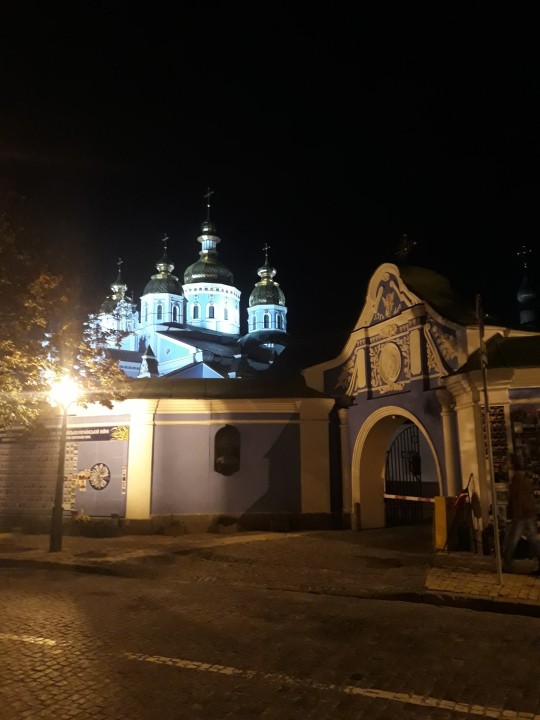
Михайлівський золотоверхий монасти - St. Michael's Golden-Domed Monastery Kyiv, Ukraine.
The sky-blue St. Michael's Cathedral, with its fabulously shining domes, is one of the most beautiful and important Orthodox temples in Ukraine. Built in the 90s, it is a remake of the destroyed St. Michael's Cathedral, which stood on the territory of the oldest monastery of Kyivan Rus for over eight centuries.
The grandson of Yaroslav the Wise, Prince Sviatopolk, founded the cathedral in the early 12th century. It is named in honor of St. Michael - the protector of Kyiv. Its nickname, the Golden-Domed Cathedral, comes from the fact that was is the first and only church with such extravagant domes in ancient Rus. Byzantine master architects participated in the Cathedral’s construction. Yet elements of Ukrainian architectural style also come through clearly. At the same time the cathedral was built, smaller buildings also sprung up around it.
The church became the most honored religious monument among the residents of Kyiv. Its importance grew in 1108, after it got its main shrine - the relics of the St. Barbara, brought to Kyiv from Constantinople. Since the original cathedral was destroyed, these relics have been kept in St. Volodymyr's Cathedral in Kyiv.
Although the monastery was severely damaged during the Mongolian Tatar invasion, it continued to prosper and grow, mostly due to the efforts of Polish kings and (later) Ukrainian Hetmans. In the 16th century, St. Michael's Monastery was one of the richest cloisters in Kyiv. One century later, it was almost completely rebuilt, adding Ukrainian baroque details.
St. Michael's Cathedral is famous for its unique mosaics and frescos, which are rightfully considered to be the greatest creations of the Old Russian monumental painting. Its mosaics are nicknamed ‘glimmering,’ because of their exquisiteness and shine. When the temple was completely demolished by the Soviets in 1937, the valuable mosaics were rescued. Some of them were kept in the St. Sophia Cathedral, others were taken to the Hermitage Museum in St. Petersburg and the Tretyakov Gallery in Moscow. After the cathedral’s reconstruction, all of them were returned.
Today, the St. Michael's monastic complex includes, along with the rebuilt cathedral, a refectory with the Church of St. John the Divine and a bell tower, created in the 18th century. A museum dedicated to the history of the St. Michael's complex operates inside the bell tower. Its unique exhibition tells in detail about the significance and the tragic history of the cloister, along with other religious buildings in Kyiv demolished by the Bolsheviks. Fantastic views on the Ukrainian capital open up from the bell tower of the monastery.
information from; https://discover-ukraine.info/places/kyiv/kyiv/166
#Михайлівський золотоверхий монастир#St. Michael's Golden-Domed Monastery#kyiv#kyivphoto#kyiv ukraine#київ#history#original photography#photography#my photography#my photos#original photographer#original photography blog#photographers of tumblr#photographers on tumblr#український tumblr#ukrainian art#ukrart#ukraine#україна#український блог#український пост
21 notes
·
View notes
Text
The Campaign of the Biorobots
An early photo of the destroyed reactor hall at CHNPP. Highly radioactive debris covers the roofs in front of and behind the ventilation chimney, as well as several other lower roofs.

The explosion at the Chernobyl Atomic Energy Station on the morning of April 26th, 1986, ripped apart the very core of the reactor itself. Debris from this explosion was scattered over a large area, mostly on the grounds of the plant itself. Much of it ended up at the base of the northern wall of the reactor hall, which had itself collapsed. The remaining majority of this debris was thrown onto the roofs of the plant building, which itself had many levels and tiers. All of this debris was dangerously radioactive and much of the radiation close to the plant came from this debris.
The Soviet government, eager to be done with the Chernobyl Accident, set blisteringly tight deadlines on the liquidation efforts. To finish the Sarcophagus, an important milestone set by the government, the debris had to be cleared. They also demanded the plant be made safe so that the other three undamaged reactors could be reactivated to salvage some of their badly damaged reputation both domestically and abroad. Without clearing the debris, the reactor building of Unit 3 would have so irradiated that it would not be safe to send personnel to operate it.
The debris itself was composed of reactor components, primarily graphite, metal piping, and other assorted hardware, such as control rods and fuel assemblies. Some debris was also parts of the destroyed reactor hall. Uranium fuel pellets were also common in this area. They were still so active that they melted down into the bitumen roofing of the plant, essentially gluing them to the roof.
Radiation levels around the plant were edging apocalyptic, but they were nowhere near the levels on the roofs of the plant. These roofs were split into three areas by elevation and radiation level and named after three women related to General Nikolai Tarakanov, deputy commander of the Civil Defense Forces of the USSR. Area Katya had the lowest level of radiation, at about 1,000 roentgen per hour. Area Natasha was twice as active, with up to 2,000 roentgen per hour. But they both paled in comparison with Area Masha. This roof, the smallest but highest of the three, had fields of up to 10,000 roentgen per hour. It would take less than three minutes to receive a lethal dose here.
Below: A map of the three named roofs.

Photo credit: u/0utlander
Clearing this debris and decontaminating the buildings was a monumental task. The Chernobyl plant, an enormous construction, had many different levels to its roof that now needed to be reached and then cleared by the commission in charge of liquidation efforts. Made up of several different representatives of different ministries and enterprises within the Soviet government, they had the all resources of the USSR at their disposal.
The commission turned to NIKIMT, a Soviet think tank. This laboratory had already invented several solutions to many problems within the Chernobyl Zone, and this time they delivered another cheap yet effective idea. They proposed laying huge cloth sheets covered in water soluble glue on top of the debris, and then when the glue dried lifting the sheets away via one of the large cranes already on site building the Sarcophagus and burying it as high level radioactive waste. However, SREDMASH refused to let them use any of the cranes to test these out, as Sarcophagus construction needed to continue 24 hours a day. After this setbacks NIKIMT then proposed lifting the sheets with helicopters, but were again denied due to the dust these helicopters would kick up.
The Ministry of Energy, responsible for reactivating and subsequently operating the plant, had its own plan. They would use robots to clear the debris. Two Soviet lunar rovers were brought out of storage and retrofitted with bulldozer blades and a frame to attach a wire to lift them onto the roof via helicopter. Also brought in was a specialized West German robot named ‘Joker’, which was designed specifically to handle radioactive material. These robots had some success, notably in Zone K. Ultimately however, these robots all failed. Their circuits were severely damaged by the gamma radiation fields on the roofs, and they got stuck on debris and in the bitumen roofing. Even Joker, supposedly designed to operate in such hostile environments, got stuck when it drove over a piece of graphite and got it lodged in its treads. When it was retrieved, it was revealed it too had succumbed to the gamma field. Whoever had ordered it from West Germany had immensely underrepresented the level of radiation it would be facing.
Below: A retrofitted lunar rover cleans debris off of Zone K before its untimely demise.

Below: The West German robot, Joker, is checked over by technicians before being deployment on the roof of the plant.

On September 16, 1986, the government commission convened for an important meeting. All other means of clearing the roof had failed, and the specialists of the Ministry of Energy requested that men be sent to clear the rooftops. This unpleasant prospect had been long delayed in the hopes of finding a better solution, but now it remained the only choice to clean the roof before the completion of the Sarcophagus.
General Tarakanov began preparations to send the men under his command to the roof. He set up a mock rooftop complete with real graphite blocks and reactor components, pulled from the unfinished reactors 4 and 5, which had been under construction at the time of the accident. Since they were never used, these components were not radioactive. Protective clothing was procured, and tests were conducted on its effectiveness and the level of radiation a soldier would absorb working in the area. Routes were planned to the roofs. It was determined that the waste from the roofs would be thrown into the ruins of Reactor 4, to be sealed away under the Sarcophagus with the rest of the reactor.
Below: General Nikolai Tarakanov debriefs a group of biorobots after their sortie at the CHNPP. Tarakanov was well respected by his men and the other government ministers for taking a leading role in cleaning the roof. He personally handed out the bonus awarded to every group of biorobots after their mission and supervised the missions daily. Liquidators were limited to only 25 REM (roentgen equivalent man, basically total exposure), but the general spent so much time at the plant that he accumulated a dose of nearly 200 REM. He survived after hospitalization.
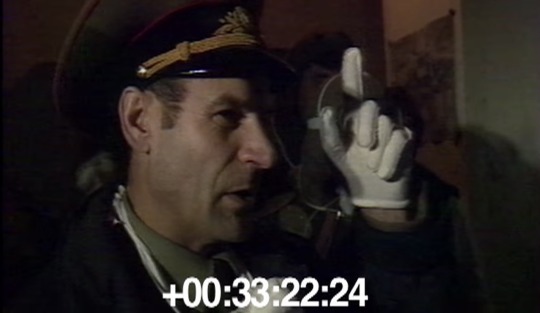
The soldiers assigned to clean the roofs, known (with not a little irony) as 'bio-robots', were outfitted with heavy leather aprons, lead sheeting torn from within buildings in Pripyat for their chests and heads, respirators, and goggles. They were given shovels and rakes to clear debris, stretchers and wheelbarrows to carry large pieces of graphite, and sledgehammers to smash any fuel pellets melted into the roof of the plant. The equipment was slipshod, the danger unclear, and the task monumental. But on September 19th, three days after the order to send men onto the roofs was issued, the general's men commenced their campaign.
Below: Two men help a Biorobot prepare to go out onto one of the roofs. Note the lead plate on his chest and leather apron on his back.

They went in small groups of 2-4 men, with another man timing them to limit their dose and ensure they did not linger too long on the rooftop. Most sorties lasted about a minute and a half, with some going as short as 20 seconds depending on the mission of a group. After receiving their orders, the men ascended through the maze of corridors to the roof they had been assigned to decontaminate. They donned their shielding, almost negligible in such strong radiation fields, and waited by one of several entrances to the roofs. Upon the signal of their supervisor, they would run out onto the roof, throw as much debris into the reactor ruins nearby, and then when the signal (usually a siren or a pipe hit with a hammer) was given they ran back inside of the plant. They removed the heavy and constraining aprons and shielding, and shuffled back down the stairs. Every man's contribution was marked down in a log book, with their name next to how much debris they had thrown back into the reactor. You can find footage of one of these sorties to Zone M here.
Igor Kostin, a reporter assigned to cover the accident, made five trips to the rooftops himself with cameras shielded in lead to capture the work of the biorobots. The radiation in these areas was so intense that it left ghostly waves on the film of photographs taken in these areas. You can see some of these photos below.
A group of bio robots works in Zone M, the most dangerous of the three roofs.

Below: Two biorobots carry a large graphite chunk on a wooden stretcher, again in Zone M. This method was used to carry large and unwieldy pieces that could not be lifted by shovel.

In the end, 3,828 men would work to clear the roofs of the Chernobyl Atomic Energy Station. The operation to clear them lasted from September 19th until October 1st, 12 days. The same day the operation was declared complete, Reactor 1 came online for the first time since the accident.
Radiation sickness was widespread in these men. It was common to find them curled up in the lower corridors of the plant, fighting off nausea and exhaustion. Most of these men would die young, some mere years after Chernobyl. All of them were given a little red certificate of commendation and a small cash bonus, but very little recognition was given to them after the completion of decontamination. Without them, the plant would have remained dangerously radioactive and radioactive waste would have been exposed to the atmosphere and environment for years.
Below: A group of biorobots await deployment at the CHNPP.

#chernobyl#chernobyl hbo#accidents and disasters#history#biorobots#nuclear power#radiation#nuclear#autism#disaster#reactor#chnpp#general tarakanov my beloved
48 notes
·
View notes
Text


Governor Ronald Reagan, in his 1967 inaugural address, famously remarked, “Freedom is a fragile thing and it’s never more than one generation away from extinction.”
Reagan today might have expanded on his theme by declaring that civilization itself is both fragile and can lost by a generation that recklessly spends its inheritance while neither appreciating nor replenishing it—if not ridiculing those who sacrificed so much to provide it.
Such is the noxious epitaph of the Baby Boomer generation that is now passing after a half-century of preeminence and whose Jacobin agendas have nearly wrecked the nation they inherited.
In contrast to them, eighty years ago this week, the Allied powers of World War II—chiefly the United States, the United Kingdom, and Canada—landed on five Normandy beaches to begin what Gen. Dwight Eisenhower, supreme commander of the Allied expeditionary forces, would call the great “crusade” to liberate Western Europe from four years of brutal Nazi occupation.
The plan was to land within a few hours and in stormy weather well over 150,000 Americans, British, and Canadians on the Atlantic Coast beaches of France, where they were to charge directly into the fire of tens of thousands of enemy troops. They were to charge uphill in the sand while being fired upon by entrenched German troops occupying the hills above. From there, the beachhead was to serve as the launching pad for two million more troops, who were to somehow drive eastward through France and into Germany to end the war and the devastation the Third Reich had inflicted on the world.
All that was accomplished in the ensuing 11 months. That can-do American generation assumed that impoverished teenagers emerging from the Great Depression, with equipment often inferior to their seasoned German enemies, would, over the ensuing months, surely prove able to route Waffen SS veterans. Many of them were hastily transferred from the murderous Eastern Front, such as the nihilist 2nd SS Panzer Division das Reich (“The Empire”). No matter, the Americans did the impossible in less than a year—from the Normandy beaches to well across the Rhine River.
That same generation went on to save South Korea, build an anti-totalitarian world order, defeat Soviet communism, and pass on to the Baby Boomer generation the strongest economy, military, and political system in history, or, to paraphrase the poet Horace, “monuments more lasting than bronze.” Or so we, the inheritors, thought.
And what are the now septuagenarian and octogenarian children of the veterans of Omaha Beach and Iwo Jima, leaving as their own legacy?
The self-infatuated and do-your-own-thing generation that gave us the Sixties and the counterculture has left the country $36 trillion in debt, now borrowing $1 trillion nearly every three months. Worse, there is not just no plan to balance budgets, much less to reduce the debt, but also no intention to stop or even worry about the borrowing of some $10 billion a day.
The U.S. military is almost unrecognizable to that of just a few decades ago. It was humiliated in Kabul. In surrealistic fashion, it abandoned some $50 billion in lethal weaponry to the Taliban—along with our NATO allies, American contractors, and loyal Afghans. And our supreme command labeled that rout a brilliant retreat. Meanwhile, the military suffers from depleted inventory of key munitions while being short 45,000 annual recruits.
The Pentagon is torn by internal dissension over DEI, woke, anti-meritocratic promotions, and a politicized officer class—well, apart from now also being outmanned and outgunned by the Chinese. Many of the world’s key maritime corridors—the Red Sea, the Straits of Hormuz, the Black Sea, and the South China sea—are apparently beyond our navy’s ability to ensure the world safe transit.
For perceived cheap political advantage, the Baby Boomers destroyed the southern border, most recently allowing in nearly 10 million unaudited illegal aliens. With the disappearance of our national sovereignty, so too was lost the once-cherished idea of a melting pot of legal immigrants arriving in America longing to assimilate, to integrate in self-reliant fashion, and to show gratitude for the chance of something far better than what they left.
The country’s major cities are increasingly medieval, with a million homeless camped on fetid streets. Criminals terrorize the law-abiding. They assume their violence will be contextualized away by vacuous “critical legal” or “critical race” or “critical penal” theories. This generation releases violent felons to prey on the weak and sheds hardly a tear as police officers are shot unnoticed at the rate of nearly one a day.
America’s once great universities—such as Harvard, Yale, Princeton, Stanford, and MIT—are now into their fourth year of abolishing much of their prior standards. The youth who sought to wreck them from the outside in the 1960s now succeed in finishing the job as elders on the inside. These bankrupt campuses now adjudicate admissions and hiring by race, tribe and gender and then wonder why their students are entitled, ignorant, and arrogant yet unable to meet the very standards that the universities once insisted were critical to ensuring their preeminence.
Worse, the more elite the campuses, the more they became hotbeds of unapologetic anti-Semitism, gratuitous violence, and hatred for the country’s very institutions that guarantee their own freedom of action and speech. Who taught them and allowed them to think that as they illegally occupied buildings, defaced and defiled monuments, and shouted Jew hatred, they were absurdly entitled to free food deliveries and amnesties?
A rapacious higher education welcomed in profitable anti-American students and billions of dollars in hostile foreign cash from those who mock the laws of their host and feel a covetous America can be bought for 10 cents on the dollar. And as we learned after October 7, they were mostly correct.
Abroad, our nomenklatura opportunistically demonizes a democratic Israel trying to fight a terrorist Hamas that slaughtered 1,200 mostly unarmed citizens at a time of peace in the most grotesque fashion of the 21st century.
Yet our elite cannot distinguish killers from our democratic allies. Hamas deliberately drafted their own citizens to serve as shields to protect the terrorists safely ensconced in the tunnels below—on the sick assurance that Israel would surely try to avoid killing civilian shields whom the cynical Hamas apparat deliberately exposed to protect itself.
America hectors its most loyal ally in a way it does not its chief enemies, communist China and theocratic Iran. Not content with hiding its role in birthing the gain-in-function COVID-19 virus, now with impunity China helps kill 100,000 Americans a year through the export of fentanyl. It sends nearly 30,000 adult males into the US illegally. It relies on the espionage abilities of its students and visitors —and apparently exempt spy balloons—to ensure the People’s Liberation Army’s technological parity with the U.S.
But the greatest baleful legacy of this fading generation is the weaponization of the government against its own perceived American citizen enemies. That bastardization of institutions extends now to the very destruction of the once-hallowed tradition of American jurisprudence.
The degeneration was not just that our government and its political ancillaries cooked up the Russian collusion hoax that warped the 2016 campaign and crippled a presidency—but that, to this day, its unapologetic architects remain smug that they pulled it off and would do it again.
Ditto the efforts of “intelligence authorities” to delude the American people about “Russian disinformation” and the Hunter Biden laptop. The Sixties generation’s new normal is to impeach a president twice, to try him as a private citizen, and to seek to remove him from state ballots.
All that was now characteristic of a generation that learned in the 1960s that if it did not get its way, it would wreck what it could not control. So, it was logical that it sought to pack the court, to end the filibuster, to destroy the Electoral College—and to corrupt the law to achieve political ends. Or as the Sixties generation taught us, “by any means necessary”—an arrogant affirmation of Machiavelli’s dictum that “the ends justify the means.”
Now we are left with a final toxic gift from this generation: the destruction of jurisprudence, a system designed not to easily protect the popular and admired but those often pilloried in the public square, the unorthodox, eccentric, and unliked.
Even Trump’s antagonists know that had Donald Trump been a man of the left, or had he not run again for president, he would never have been charged, much less convicted, of felonies or been punished with nearly a half-billion dollars in legal fees and fines.
We all accept that the charges brought against him by a vindictive and left-wing Letitia James, Alvin Bragg, Fani Willis and Jack Smith—all compromised by either past politicized prosecutorial failures or boasts of getting Trump—have never before been brought against any prior political figure or indeed any average citizen. They were instead invented to target a single political enemy. So what hallowed law, what constitutional norm, what ancient custom, or what Bill or Rights has the fading left not destroyed in order to erase Donald Trump from the political scene?
There is now no distinction between state and federal law. Once a prosecutor targets an enemy, he can flip back and forth between such statutes to find the necessary legal gimmick to destroy his target.
Statutes of limitations are no more as errant prosecutors and political operatives in the legislature can change laws to dredge up supposed crimes of years past, to destroy their political enemies, by employing veritable bills of attainder.
The very notion of an exculpatory hung jury depends on who is to be hung.
Judges can overtly contribute to the political opponents of the accused before them. Their children can profit in the tens of millions by selling to politicos their relationship to the very judge who holds the fate of their political opponents in his hands.
In sum, the First Amendment guaranteeing the right of the defendant to free speech is now not applicable. Asymmetrical gag orders are.
The Fourth Amendment is now torn to shreds by those who boast of “saving democracy.” When the FBI, on orders from a hostile administration, storms into the home of the leading presidential candidate and ex-president’s home, armed to the teeth, treats a civil dispute as a violent felony, and then doctors the evidence it finds, then constitutional insurance against “unreasonable searches and seizures” becomes a bitter joke for generations.
The Fifth Amendment’s protection that no person “shall be deprived of life, liberty, or property, without due process of law” has been destroyed when an ex-president cannot summon expert legal witnesses to testify on his behalf and when he cannot bring in evidence that contradicts his accusers. There is no due process when one ex-president is indicted for the very crimes his exempted successor has committed.
The Sixth Amendment’s various assurances are now kaput. No one believes that Trump was tried “by an impartial jury of the State”—not when prosecutors deliberately indicted him in a city where 85 percent of the population voted against him and are by design of a different political party.
No longer will an American have the innate right “to be informed of the nature and cause of the accusation; to be confronted with the witnesses against him; to have compulsory process for obtaining witnesses in his favor” when Donald Trump was never informed by prosecutor Alvin Bragg of the felony for which he was charged, with little advance idea of all the hostile prosecutorial witnesses to be called, and with no right to call in experts to refute the prosecution’s bizarre notion of campaign finance violations.
The Seventh Amendment is likewise now on the ash heap of history. The publicity-seeking judge Arthur Engoron, a political antagonist of Trump, warped the law in order to serve as judge, jury, and executioner of Trump’s fate, without recourse to a jury of even his biased New York peers.
The Eighth Amendment will offer assurance no longer to the American people that “excessive bail shall not be required, nor excessive fines imposed, nor cruel and unusual punishments inflicted.”
Donald Trump was fined $83.3 million in the E. Jean Carroll case for an alleged assault of three decades past, brought by partisan manipulative waving of the statute of limitations, with the politicized accuser having no idea of the year the assault took place, with her accusations arising only decades later when Trump became a political candidate, with her own employers insisting she was fired for reasons having nothing to do with Donald Trump, and with her narrative eerily matching a TV show plot rather than any provable facts of the case.
By what logic was Trump fined $175 million for supposedly inflated asset valuation to obtain a loan that was repaid with interest to banks that had no complaint? Since when does the state seek to inflict such “unusual” punishments for a crime that never before had existed and never will again henceforth?
In sum, our departing weak-link generation leaves us this final Parthian shot— that when a toxic ideology so alienates the people who are rising up to prevent its continuance, then the desperate architects of such disasters can dismantle the rule of law to destroy its critics.
And so, a single generation has broken apart the great chain of American civilizational continuance. But if this weak-leak generation thinks the evil that they wrought is their last word, they should remember the warning of a great historian:
“Indeed men too often take upon themselves in the prosecution of their revenge to set the example of doing away with those general laws to which all alike can look for salvation in adversity, instead of allowing them to subsist against the day of danger when their aid may be required.”
– Thucydides 3.84.3
3 notes
·
View notes
Text
A yearlong investigation by a team of scholars affiliated with Cornell and Purdue universities has documented a pattern of deliberate obliteration of Armenian cultural heritage in Nakhichevan, a historically Armenian region that became part of Azerbaijan following the Sovietization of the republics of Armenia and Azerbaijan between 1920 and 1921. The new report by the Caucasus Heritage Watch (CHW) identified 108 medieval and early modern Armenian monasteries, churches, and cemeteries in Nakhichevan that were completely destroyed between 1997 and 2011 — an eradication described by the report’s authors as a “striking portrait of cultural erasure that, in its surgical precision, totality, and surreptitiousness, has few parallels.”
Of all the Armenian cultural heritage sites that CHW was able to locate and assess for this investigation, 98% have been completely wiped out. For all practical matters, destruction has been complete: the percentage has been noted for the sake of statistical accuracy, as the ruins of some very few monuments have escaped the attention of Azerbaijani authorities only because they are in such advanced state of disrepair that they were not able to identify them as Armenian, the researchers believe. “By 2011, all physical traces of Armenians in Nakhchivan were effectively gone, with rare exceptions appearing to have resulted from oversight rather than intent,” the report says. Proportionally, the degree of destruction is greater than the elimination of mosques by the Chinese government in the Xinjiang Uyghur region [according to the highest number claimed by Lockheed-funded think tank ASPI]
323 notes
·
View notes
Text

in this post, a russian talks about a Polish movie with adult man/underage teenage girl romance plot, saying that there's no age when it comes to true love. again, we are talking about a movie with statutory rape as the main romance subplot. the main plot, even.

first post of their blog, however, starts with a video about Polish people destroying soviet monuments (dunno if it's even a thing) and the text of the post itself is talking about nazis and need to destroy them once again.
This post tells us that:
russia attacked Poland in 1939 along with Germany, because Soviets and Nazis were allies;
russians are currently using accusations of nazism to justify genocide;
russians accusing Polish people of nazism now;
and, oh, русня йобані педофіли.
4 notes
·
View notes
Text
As Moscow’s relations with the West have deteriorated since the February 2022 invasion of Ukraine, monuments to Polish and Lithuanian victims of Stalinism and Finnish soldiers killed in World War II have systemically vanished from cities across Russia. Some officials say the disappearances are only temporary while restoration work is underway, but more often, they claim ignorance and blame anonymous vandals. At the same time, there’s typically no police response when a memorial is damaged or goes missing. Meduza reviews the monuments dismantled and disappeared in the past year.
Yakutsk
On September 25, the news outlet SakhaDay reported the disappearance of a local monument to Poles and Lithuanians exiled during the Soviet period between 1941 and 1947. Erected in 2002, the memorial comprised several large stones with plaques bearing the names of individuals sent to Soviet labor camps.
In the spring of 2023, a construction fence appeared around the monument. That summer, the plaques with people’s names vanished. While this was happening, local officials said they didn’t know who was responsible. In September 2023, even the large stones disappeared. The city’s authorities haven’t commented further.
Priozersk, Leningrad region
In mid-September, a monument dedicated to Finnish soldiers killed in World War II went missing in Priozersk, locals told journalists at Fontanka. The headstone, which bore the names of 130 Finnish soldiers buried at the site, was installed in June 2019 on the basis of an agreement between Russia and Finland. According to the town’s authorities, Finnish officials participated in the memorial’s unveiling ceremony.
Following the headstone’s disappearance, officials explained that the town isn’t responsible for the monument and said they have no knowledge of its whereabouts. A nearby monument also dedicated to fallen Finnish soldiers, erected in 1996, is still in place at the time of this writing.
Galyasher, Perm Krai
In April 2023, someone destroyed a monument in Galyasher to Poles and Lithuanians deported east from the USSR’s western regions in 1945. The town’s forced settlement was home to between 60 and 80 families. Many deportees died from starvation and brutal working conditions at the local sawmill. Survivors returned to their homes in 1957.
The memorial in Galyasher was erected in August 2016 with funding from individuals in Lithuania. Despite campaigning by human rights activists, the town never officially recognized the monument.
The police inspected the demolished site and found no grounds to open a criminal investigation, but the local prosecutor’s office rejected this finding and ordered another review in June. Nothing new has been reported since then.
St. Petersburg
In late July, a monument to Leningrad’s Polish victims of the Great Terror disappeared from the Levashovo Memorial Cemetery. Located at the site of an NKVD mass grave, the cemetery is the final resting ground for thousands of Soviet citizens executed at the height of Stalinism. There are memorial signs devoted to the memory of different nationalities targeted in the terror: Estonians, Ukrainians, Norwegians, Jews, and others.
Local officials have not commented on the missing memorial to Poles. A source in Town Hall told the news agency TASS that vandals attacked the monument, which was then sent for repairs, but human rights activists have failed to get the city to explain who ordered the renovations and where the monument is now.
Sverdlovsk region
In June 2023, monuments to deported Poles were dismantled in the towns of Kostousovo and Ozernyi. The memorials were erected 20 years earlier in an initiative by Poles who lived in the Urals after they were forcibly relocated following the USSR’s annexation of eastern Poland in 1939.
Unknown persons removed the plaques brought from Poland, a cross, a figure of Jesus Christ, and an image of the Virgin Mary. Local police departments are reportedly investigating the incidents.
Rechka Mishikha, Buryatia
In early June 2023, someone destroyed a monument to the Polish political prisoners killed in the Baikal Insurrection of 1886.
A wooden Catholic cross and marble tablet overlooking a stone embankment, the memorial opened in October 2001 at a ceremony attended by Poland’s consul general in Irkutsk and members of Buyatia’s regional government.
In recent years, local residents reportedly complained about the monument, arguing that its presence is inappropriate amid deteriorating relations with Poland.
Pivovarikha, Irkutsk region
In mid-May, a Polish monument and a Lithuanian cross were dismantled in the town of Pivovarikha at a site dedicated to Soviet Terror victims. In the 1930s, the NKVD executed between 15,000 and 17,000 political prisoners in the area. The memorials to Polish and Lithuanian victims were erected with private funding.
Within a few days of the monuments disappearing, regional officials in Irkutsk acknowledged that public workers had removed the two shrines and placed them “in storage” because their installation was deemed illegal. “The surnames of those executed in the Irkutsk region, including Lithuanians and Poles, are inscribed on the walls of the memorial erected at the site in 2021. Their memory is preserved,” officials explained.
Tomsk
Last year on Polish Independence Day, November 11, someone in Tomsk ripped the memorial plaque off a local monument to the Polish victims of the Great Terror. The memorial was erected in 2004.
Two days later, someone vandalized a former shelter for the children of Polish deportees, tearing off a plaque outside the building that was dedicated to their memory. The same plaque had already been stolen in 2016 and replaced in 2020 in a public initiative after the local police failed to find the perpetrators.
On December 1, 2022, some 90 miles from the Tomsk regional center, someone smashed the cross and a plaque bearing the names of Poles shot during the Great Terror in 1938. Town police in Polozovo opened a criminal investigation, but there have been no updates since. In June 2023, the local Catholic community restored the cross.
16 notes
·
View notes
Text
A horrifying report from 2017, showing that as many as 10 000 Chinese were murdered by their government during the Tiananmen Square massare between June 3-4 1989 (the actual protests spanned several weeks).
This part is utterly sickening:
The envoy wrote: "Students understood they were given one hour to leave square but after five minutes APCs attacked.
"Students linked arms but were mown down including soldiers. APCs then ran over bodies time and time again to make 'pie' and remains collected by bulldozer. Remains incinerated and then hosed down drains.
"Four wounded girl students begged for their lives but were bayoneted."
All of this demonstrates the evil of communism. It is communism's utopia of a controlled society masquerading as the pursuit of "equality" that gave rise to the monumental atrocities of the 20th century, from the gulag system to the mass starvation of Mao's "Great Leap Forward".
It was communism's incoherent ideology that sought to destroy man's right to be free, to say what he pleased, to pursue his own course in life without government control. By destroying fundamental human dignity and freedom, communist rulers gave themselves carte blanche to extricate the 'undesirables' from society using whatever means at their disposal. Dissidents and even former allies found themselves hounded out of polite society, followed, attacked, falsely imprisoned, and executed.
Given the scale of misery and evil visited upon millions during the last century, it angers me to see communist and Marxist fanatics still putting up stickers in my city, asking people to join their ideology.
Perhaps this should not come as a surprise, as communists such as Mao Zedong entrenched their dictatorship by demanding that people forgot history. The past was portrayed as a relic of imperalism, to be a source of shame and rejection. The Communists were to be the saviours, bringing about the promised brotherhood of man.
Likewise, those who continue to hold to Marxism and Marxist-Leninism must likewise demand that people either downplay or whitewash history. The hellish reality of the communist utopia would hardly draw fans from a free country.
Furthermore, I imagine that such ideologues can only sell their contaminated goods in a decadent, increasingly cowardly, and self-hating West. Subverting Western civilisation in order to posit communism as the only viable alternative was always a strategic goal of 20th century communist regimes. In places such as Eastern Europe, where people who remember the horrors of Soviet rule still live, I imagine the communist message would not be so well received.
We must defy the murderous Chinese government by loudly remembering all those slaughtered for simply demanding political reform. Memorials to those murdered at Tiananmen Square should take place outside Chinese embassies worldwide, letting free people know what kind of evil Chinese diplomats are representing, and asking them whether they will continue to allow CCP influence over European countries.
It's time for China's impunity to end.
#tiananmen square#tiananmen massacre#china#chinese#chinese history#tankman#peking#marxism#marxism leninism#communism#anti communist#europe#rest in peace#bbc#mao#stalin
2 notes
·
View notes
Photo

New Post has been published on https://massispost.com/2024/02/ethnic-cleansing-of-nagorno-karabakh-a-continuation-of-azerbaijans-policy-of-terror-armenian-mfa-on-anniversary-of-sumgait-massacre/
Ethnic Cleansing of Nagorno Karabakh a Continuation of Azerbaijan’s Policy of Terror: Armenian MFA on Anniversary of Sumgait Massacre

YEREVAN — Azerbaijan continues its policy of eradicating any Armenian traces under its control, desecrating, vandalizing and destroying Armenian religious and historical-cultural monuments, the Armenian Foreign Ministry said in a statement on On February 27, 1988, at the initiative of the leadership of Soviet Azerbaijan and under the conditions of absolute negligence, the massacres of the Armenian population of Sumgait began, accompanied by cases of violence, brutality, forced disappearances, dispossession, and massive violations of human rights. Hundreds of Armenians were killed, including women, children and the elderly, and thousands of Armenians were forcibly displaced. “The Sumgait tragedy was followed by…
4 notes
·
View notes